When Gadgets Fail - Range Finding Reticles
By Darrell Holland
[floatright]
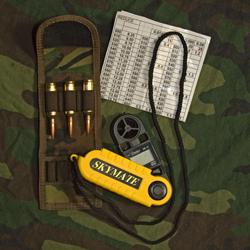 [/floatright]It's great living in a technological society. The shooting world has been blessed with its share of techno-gadgets in recent years. Wind meters, laser range finders and sophisticated ballistic programs have taken the guess work out of most of our honed and practiced skills.
[/floatright]It's great living in a technological society. The shooting world has been blessed with its share of techno-gadgets in recent years. Wind meters, laser range finders and sophisticated ballistic programs have taken the guess work out of most of our honed and practiced skills.
Now the neophyte can accurately judge range to the nearest yard and determine wind deflection to the fraction of an inch given a constant blow. Such luxuries were not available to the likes of Daniel Boone, Billy Dixon or Davy Crocket. They had perfected these learned skills from years of practice and experience. Billy Dixon shot thousands of rounds in the extermination of the American bison and this experience made him one with his rifle. He was quite proficient in judging distance, wind and knew the ballistic profile of his handcrafted load. The buffalo hunters were indeed some of the finest game shots in American history due to the nearly inexhaustible number of targets available during that era. They shot in wind, rain, sleet, snow, scorching heat and a host of other "Postal Conditions" that would confound today's shooter's.
As a Generation of techno-shooters, many of us have become dependant on such gadgets. The laser rangefinder being the most used crutch in our shooting bag. How many of you still reach for the LRF when the target is within point blank range? We've developed a phobia that unless we know the exact range to the target we might miss? Hmmm.... Daniel Boone would not be impressed!
Most importantly, what do we do when our laser flat-lines due to snow, rain, fog and or poor reflectivity? During these moments of techno-failure our language would be embarrassing if used in mixed company.
I posed this question to hundreds of shooters at the Safari Club International show in Reno, Nevada this year and a very high percentage of shooters did not have a suitable answer. Many thought they could buy competence in "Testosterone" based magnums and zero their rifle at 300-400 yds in an attempt to overcome such embarrassing situations.
One hunter who was headed to Mongolia for Marco Polo sheep was told to zero his 300 Win. Mag. at 500 yards as shots tended to L O N G on these wary trophies. If they encountered game between 200 and 325 yds the bullet would be 14-15 inches high at those ranges! If a trophy sheep is spotted at 275 yards, will our hunter remember to hold 15 inches below his desired point of impact? Having watched numerous hunters in the field, I'd be willing to bet there would be no back straps on the campfire that night?
A Remington 300 Ultra Mag shooting a 180 bullet at 3250 fps. with a 400 yd zero will be 8.52 inches high at 225 yards. Very few shooters realize just how high the bullet will be at ranges between 150-300 yds. Don't make this mistake, there is a better solution and you've been staring at it for years.
Reticle Salvation
[floatright]
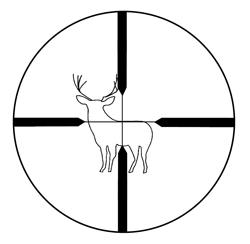 [/floatright]That's right, when the laser fails and conditions are such that you cannot accurately judge distance to target, use the reticle in your scope. With a little practice you'll find it is easy to do and far more accurate than Mark 1 eyeball. Military and law enforcement shooters have used the scopes reticle for decades to accurately determine range to a target of a given size. Hunters can also use the same technology to bring home the trophy under inclement conditions.
[/floatright]That's right, when the laser fails and conditions are such that you cannot accurately judge distance to target, use the reticle in your scope. With a little practice you'll find it is easy to do and far more accurate than Mark 1 eyeball. Military and law enforcement shooters have used the scopes reticle for decades to accurately determine range to a target of a given size. Hunters can also use the same technology to bring home the trophy under inclement conditions.
Most American and a few European scopes have the reticle installed in the Second Focal Plane, meaning the reticle remains a constant size and the image ( deer, elk, prairie dog ) increases or decreases as we turn the magnification up or down. Second Focal Plane scopes are usually calibrated on their highest magnification setting. It is important to note your calibrated setting.
In First Focal Plane scopes, the reticle and target size increase or decrease proportionally with magnification changes allowing the shooter to range and shoot on ANY magnification setting. First focal plane technology is primarily a European scope feature, however a few of the American scope companies are noting the importance of being able to range and shoot on any magnification. Savvy shooters are welcoming the change.
Lets take a look at how the average shooter can use his "Duplex" reticle to range a target.
As an example; let's range an 18" mule deer. Take your target backer and set it at 100 yds. Using a felt marker, draw a 6" tall letter "I" on the target backer. From a solid rest, turn the power selector ring on your scope so the heavy post of the "duplex" and the horizontal crosswire bracket the "I" from top to bottom. Note the "magnification setting" on your scope that allows you to subtend 6 inches at 100 yds. We have now converted an angular unit of measure "Inch of Angle" to something that we can use.
On this magnification setting we can now determine the range to our target. We know that our "Duplex" subtends 6 inches at 100 yards and because we are working with an "Angular Unit of Measure", the subtension at 200 yds. is 12 inches, at 300 yds. 18 inches and at 400 yds. 24 inches. Our mule deer measures 18 inches from the top of the back to the brisket, if we bracket our deer using the duplex we can be pretty certain that he is very close to 300 yards away and hold accordingly for the shot.
Our deer is properly bracketed using the duplex reticle with a subtension
of 18 inches at 300 yards.
A more sophisticated and accurate method of range finding involves the use of Mil-radian and Minute of Angle units of measure. These again are Angular Units of Measure like "Inches of Angle" that start from the shooter and go to infinity. The Mil-radian scale has been used by the military for over a century to call artillery. A circle is divided into 6400 equal parts; one mil-radian is 1/6400 of a circle. In laymen terms this equates to 3.6 inches per 100 yards, 7.2 inches at 200 yards and 36 inches at 1000 yards.
Using the "Minute of Angle" scale, a circle is divided into 21,600 equal parts. A circle contains 360 degrees and each degree contains 60 minutes of angle. A minute of angle is a finer angular unit of measure than a mil-radian and is the most popular method of angular correction when shooting long range. One minute of angle will subtend 1.047 inches per 100 yards, 2.094 inches at 200 yards and 10.47 inches at 1000 yards.
Since we know the angular subtension at a given distance, we need to know the target size we are trying to range. It becomes a simple mathematical formula to determine the range once we know the target size we are shooting at.
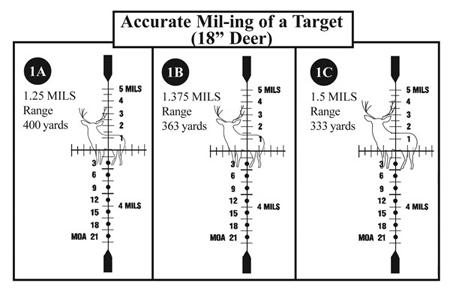
The use of the mil-radian scale has prompted a nifty tool called the Mil-dot Master that allows the shooter to accurately gauge the distance to the target by the use of a modified slide rule. The formula for using the Mil scale is as follows: Target size; width/height in inches multiplied by 27.78, divided by the number of mils the target subtends.
Example: 18 inch mule deer. 18 x 27.78 = 500.04 divided by the number of mils our target subtends ( in this example 1.5 mils) 500.04 divided by 1.5 = 333.36 yards.
New data card software can also plot the mil scale subtension allowing the shooter to have a handy pocket card with this valuable information.
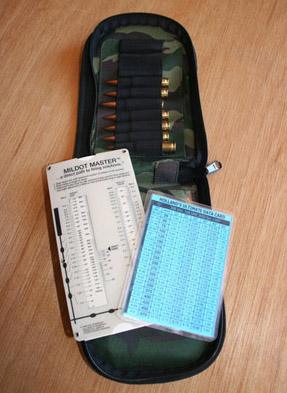
Using the MOA scale we can also determine the distance to the target. Suppose we've lost our mil-data cards and or our calculator vapor locked. Simply divide the number of "Minutes" the target subtends into the target size to determine range to the target. Example: 18 inch mule deer, bracketing our buck from the top of the back to the brisket he measures 6 MOA. Divide 18 by 6 and we get 3, our deer is 300 yards away. If he brackets 4.5 minutes of angle, 18 divided by 4.5 equals 4, he is 400 yards away. In this case we are actually using the " Inch of Angle " scale and not worrying about the extra .047 of an inch in True Minute of Angle. The extra .047 amounts to a 4.6% difference in range (at 400 yards this amounts to 18 yards) one can easily round the 4.6% to 5 % and add this to our range if so desired. This system is fast, accurate and we can do the math in our head.
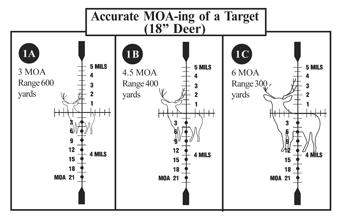
This is a basic lesson in using the reticle to determine range to the target should your laser range finder fail in the field. Often times Mother Nature intervenes on the side of the animals and renders our laser technology useless. If we are versatile and adaptable in our shooting we can remain at the top of the food chain. Successful hunters always have a back-up plan. Do you?
Advanced Reticle Technology offers both of these range finding systems in their unique reticle design. Most importantly they offer precise aiming points in Minutes of Angle eliminating the need to dial elevation when shooting long range. This reticle design is currently available in Leupold and Schmidt & Bender rifle scopes. In the next few months this reticle will also be available in the new Nightforce 5.5x22 series of rifle scopes with first focal plane technology.
Darrell Holland is a Custom Riflesmith and designer of Advanced Reticle Technology in Leupold, Schmidt & Bender and NIGHTFORCE rifle scopes. Darrell offers an intense 4 day shooting school that is ideal for long range hunters and tactical enthusiasts.
Join the discussion of this article with the author HERE at the Article Discussion Forum.
By Darrell Holland
[floatright]

Now the neophyte can accurately judge range to the nearest yard and determine wind deflection to the fraction of an inch given a constant blow. Such luxuries were not available to the likes of Daniel Boone, Billy Dixon or Davy Crocket. They had perfected these learned skills from years of practice and experience. Billy Dixon shot thousands of rounds in the extermination of the American bison and this experience made him one with his rifle. He was quite proficient in judging distance, wind and knew the ballistic profile of his handcrafted load. The buffalo hunters were indeed some of the finest game shots in American history due to the nearly inexhaustible number of targets available during that era. They shot in wind, rain, sleet, snow, scorching heat and a host of other "Postal Conditions" that would confound today's shooter's.
As a Generation of techno-shooters, many of us have become dependant on such gadgets. The laser rangefinder being the most used crutch in our shooting bag. How many of you still reach for the LRF when the target is within point blank range? We've developed a phobia that unless we know the exact range to the target we might miss? Hmmm.... Daniel Boone would not be impressed!
Most importantly, what do we do when our laser flat-lines due to snow, rain, fog and or poor reflectivity? During these moments of techno-failure our language would be embarrassing if used in mixed company.
I posed this question to hundreds of shooters at the Safari Club International show in Reno, Nevada this year and a very high percentage of shooters did not have a suitable answer. Many thought they could buy competence in "Testosterone" based magnums and zero their rifle at 300-400 yds in an attempt to overcome such embarrassing situations.
One hunter who was headed to Mongolia for Marco Polo sheep was told to zero his 300 Win. Mag. at 500 yards as shots tended to L O N G on these wary trophies. If they encountered game between 200 and 325 yds the bullet would be 14-15 inches high at those ranges! If a trophy sheep is spotted at 275 yards, will our hunter remember to hold 15 inches below his desired point of impact? Having watched numerous hunters in the field, I'd be willing to bet there would be no back straps on the campfire that night?
A Remington 300 Ultra Mag shooting a 180 bullet at 3250 fps. with a 400 yd zero will be 8.52 inches high at 225 yards. Very few shooters realize just how high the bullet will be at ranges between 150-300 yds. Don't make this mistake, there is a better solution and you've been staring at it for years.
Reticle Salvation
[floatright]

Most American and a few European scopes have the reticle installed in the Second Focal Plane, meaning the reticle remains a constant size and the image ( deer, elk, prairie dog ) increases or decreases as we turn the magnification up or down. Second Focal Plane scopes are usually calibrated on their highest magnification setting. It is important to note your calibrated setting.
In First Focal Plane scopes, the reticle and target size increase or decrease proportionally with magnification changes allowing the shooter to range and shoot on ANY magnification setting. First focal plane technology is primarily a European scope feature, however a few of the American scope companies are noting the importance of being able to range and shoot on any magnification. Savvy shooters are welcoming the change.
Lets take a look at how the average shooter can use his "Duplex" reticle to range a target.
As an example; let's range an 18" mule deer. Take your target backer and set it at 100 yds. Using a felt marker, draw a 6" tall letter "I" on the target backer. From a solid rest, turn the power selector ring on your scope so the heavy post of the "duplex" and the horizontal crosswire bracket the "I" from top to bottom. Note the "magnification setting" on your scope that allows you to subtend 6 inches at 100 yds. We have now converted an angular unit of measure "Inch of Angle" to something that we can use.
On this magnification setting we can now determine the range to our target. We know that our "Duplex" subtends 6 inches at 100 yards and because we are working with an "Angular Unit of Measure", the subtension at 200 yds. is 12 inches, at 300 yds. 18 inches and at 400 yds. 24 inches. Our mule deer measures 18 inches from the top of the back to the brisket, if we bracket our deer using the duplex we can be pretty certain that he is very close to 300 yards away and hold accordingly for the shot.
Our deer is properly bracketed using the duplex reticle with a subtension
of 18 inches at 300 yards.
A more sophisticated and accurate method of range finding involves the use of Mil-radian and Minute of Angle units of measure. These again are Angular Units of Measure like "Inches of Angle" that start from the shooter and go to infinity. The Mil-radian scale has been used by the military for over a century to call artillery. A circle is divided into 6400 equal parts; one mil-radian is 1/6400 of a circle. In laymen terms this equates to 3.6 inches per 100 yards, 7.2 inches at 200 yards and 36 inches at 1000 yards.
Using the "Minute of Angle" scale, a circle is divided into 21,600 equal parts. A circle contains 360 degrees and each degree contains 60 minutes of angle. A minute of angle is a finer angular unit of measure than a mil-radian and is the most popular method of angular correction when shooting long range. One minute of angle will subtend 1.047 inches per 100 yards, 2.094 inches at 200 yards and 10.47 inches at 1000 yards.
Since we know the angular subtension at a given distance, we need to know the target size we are trying to range. It becomes a simple mathematical formula to determine the range once we know the target size we are shooting at.

The use of the mil-radian scale has prompted a nifty tool called the Mil-dot Master that allows the shooter to accurately gauge the distance to the target by the use of a modified slide rule. The formula for using the Mil scale is as follows: Target size; width/height in inches multiplied by 27.78, divided by the number of mils the target subtends.
Example: 18 inch mule deer. 18 x 27.78 = 500.04 divided by the number of mils our target subtends ( in this example 1.5 mils) 500.04 divided by 1.5 = 333.36 yards.
New data card software can also plot the mil scale subtension allowing the shooter to have a handy pocket card with this valuable information.

Using the MOA scale we can also determine the distance to the target. Suppose we've lost our mil-data cards and or our calculator vapor locked. Simply divide the number of "Minutes" the target subtends into the target size to determine range to the target. Example: 18 inch mule deer, bracketing our buck from the top of the back to the brisket he measures 6 MOA. Divide 18 by 6 and we get 3, our deer is 300 yards away. If he brackets 4.5 minutes of angle, 18 divided by 4.5 equals 4, he is 400 yards away. In this case we are actually using the " Inch of Angle " scale and not worrying about the extra .047 of an inch in True Minute of Angle. The extra .047 amounts to a 4.6% difference in range (at 400 yards this amounts to 18 yards) one can easily round the 4.6% to 5 % and add this to our range if so desired. This system is fast, accurate and we can do the math in our head.

This is a basic lesson in using the reticle to determine range to the target should your laser range finder fail in the field. Often times Mother Nature intervenes on the side of the animals and renders our laser technology useless. If we are versatile and adaptable in our shooting we can remain at the top of the food chain. Successful hunters always have a back-up plan. Do you?
Advanced Reticle Technology offers both of these range finding systems in their unique reticle design. Most importantly they offer precise aiming points in Minutes of Angle eliminating the need to dial elevation when shooting long range. This reticle design is currently available in Leupold and Schmidt & Bender rifle scopes. In the next few months this reticle will also be available in the new Nightforce 5.5x22 series of rifle scopes with first focal plane technology.
****************************************************
Darrell Holland is a Custom Riflesmith and designer of Advanced Reticle Technology in Leupold, Schmidt & Bender and NIGHTFORCE rifle scopes. Darrell offers an intense 4 day shooting school that is ideal for long range hunters and tactical enthusiasts.
Be sure and ask for your FREE ballistic profile and DVD.
The first 50 callers will receive our Mil- Value Index Card showing
mil-values from .5 mils to 5.0 mils in 1/8th mil graduations for 8 different target sizes. This is a must have card for anyone ranging in Mils.
The first 50 callers will receive our Mil- Value Index Card showing
mil-values from .5 mils to 5.0 mils in 1/8th mil graduations for 8 different target sizes. This is a must have card for anyone ranging in Mils.
Join the discussion of this article with the author HERE at the Article Discussion Forum.

